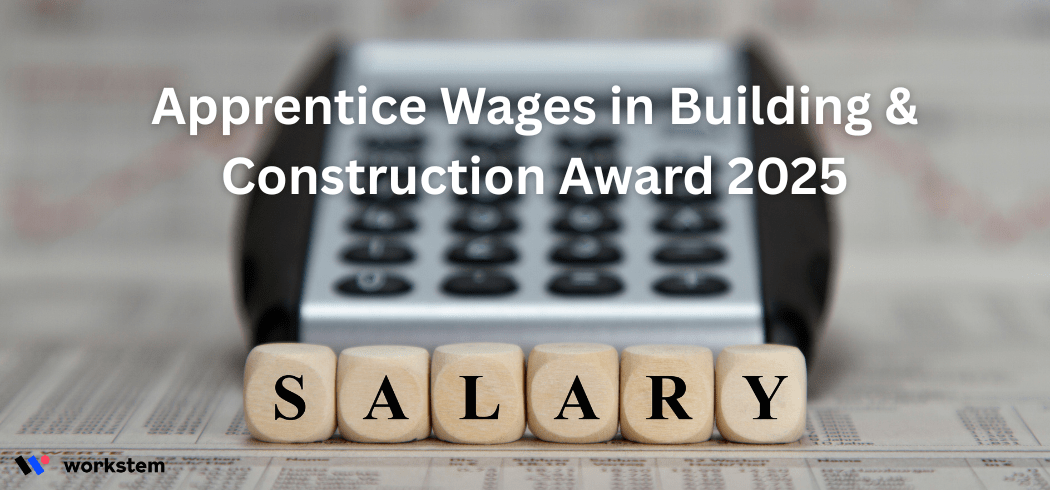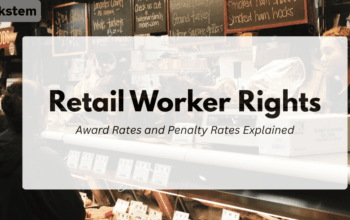Apprentices are the future of the construction industry – but paying them correctly can be tricky. The Building and Construction Award lays out specific wage rates for apprentices, which change as they progress through their training. As of 2025, these rates have increased (along with the annual minimum wage rise), so it’s crucial to ensure you’re up to date. Underpaying apprentices is sadly a common mistake, and it can lead to significant penalties and back-pay orders.
In this guide, we’ll explain who counts as an apprentice under the Award, how apprentice wages are calculated (including differences for junior vs adult apprentices), what the current rates are, and when you need to raise those rates. In short – are you paying your apprentices correctly? Let’s make sure you are.
Who Is Considered an Apprentice Under the Award?
Under the Building & Construction Award (MA000020), an apprentice is someone employed under a formal training contract to learn a trade (like carpentry, bricklaying, plumbing, electrical (if covered on-site), etc.). The Award recognizes both adult apprentices and school-based apprentices:
- Junior apprentices: These are apprentices who start under the age of 21. Most construction apprentices fall in this category. Their pay rates are a percentage of a qualified tradesperson’s rate, starting lower and increasing each year or stage of the apprenticeship.
- Adult apprentices: If an apprentice is 21 or older when they sign the training contract, they are deemed an adult apprentice. The Award gives adult apprentices special pay provisions (generally higher base pay – often at least the National Minimum Wage, which in 2025 is $948/week, or the applicable apprentice rate, whichever is greater).
- School-based apprentices: These are high school students undertaking a part-time apprenticeship while still at school. They have pro-rated wages and some extra provisions (like being paid 25% of hours for the off-the-job training time). Essentially, for every day on the job, a school-based apprentice gets paid an extra 25% of those hours to account for the day they spend in training at school.
To be an apprentice under the Award, the person must be in a registered training contract (usually 3-4 years full-time if not school-based). If someone isn’t signed up to a formal apprenticeship (say you just have a “trainee” or labourer without a contract), then they should be paid the standard labourer rates, not apprentice rates – important to note so you don’t accidentally underpay a non-apprentice by thinking you can pay them apprentice wages.
How Are Apprentice Wages Determined?
Apprentice wages are calculated as a percentage of the full trade qualified rate. In this Award, that base is generally the Level 3 rate (the pay for a qualified tradesperson in the relevant trade). The percentage depends on the year or stage of the apprenticeship. Also, whether the apprentice completed Year 12 of high school affects the starting percentage.
Here’s how it works in practice (for a 4-year apprenticeship, which is standard in construction trades):
- 1st Year Apprentice: Typically starts around 50% – 60% of the tradesperson’s rate. If the person did not finish Year 12, they start at the lower end of that range; if they completed Year 12, they start a bit higher (the Award rewards completion of high school with a slightly better starting pay).
- 2nd Year Apprentice: Jumps to around 65% – 70% of the trade rate. Again, those who finished Year 12 will be at the higher end initially.
- 3rd Year Apprentice: Around 80% of the trade rate. By the third stage, both Year-12-completers and others usually converge to the same rate (the gap closes as the training progresses).
- 4th Year Apprentice: Around 90% – 95% of the trade rate, approaching full payment. By the end of the apprenticeship, they’re just slightly under the qualified rate, since upon completion they’ll jump to 100%.
For example, suppose a tradesperson’s Award rate is about $27 per hour in 2025. A first-year (who finished Year 12) might start around $17–$18/hour, whereas one who didn’t finish Year 12 might be around $16/hour. By fourth year, both would be up around $26–$27/hour (just shy of the full rate).
There’s also a concept of competency-based progression in this Award. This means an apprentice can progress to the next pay level earlier than 12 months if they achieve the required competencies for that stage. Not all apprenticeships use this (some stick strictly to time-based yearly progression), but it’s an option. If using competency progression, you, as the employer, must bump up their pay as soon as they are signed off on the next stage – even if that’s, say, after 9 months instead of 12. Always check the training contract and qualification requirements; don’t hold someone back on first-year pay if they’ve lawfully moved to second-year status.
2025 Apprentice Pay Rates: Quick Reference
Let’s put some actual numbers to these percentages for 2025. We’ll use a common trade (Carpenter/Joiner, which falls under this Award) as an example. The Level 3 weekly rate (tradie) as of 1 July 2025 is about $1,068.40 per week (roughly $28.12/hr). Based on the Award’s percentage scales:
- 1st Year Apprentice – Completed Year 12: approx 60% of trade rate. That comes to about $655–$670 per week, which is around $17.50–$18/hr. (If they did not finish Year 12, first year is lower: roughly 55% of trade, about $604/week, or ~$16/hr.)
- 2nd Year Apprentice – roughly 70% of trade rate. That’s around $773 per week (~$20.36/hr) for someone who finished Year 12. (Not completed Year 12 might be closer to 65% ~ $720/week, ~$19/hr.)
- 3rd Year Apprentice – roughly 80% of trade rate. This comes to about $855–$881 per week (~$23.18/hr) for either category (by third year the rates align).
- 4th Year Apprentice – roughly 95% of trade rate. This is about $1,015–$1,040 per week (~$27.39/hr) – essentially almost full rate.
Now, Adult apprentices have a unique consideration: The Award says an adult apprentice must not suffer a pay cut when they start their apprenticeship if they were already employed full-time with that employer. Also, if they have no prior employment, there’s usually either a special adult apprentice rate or the national minimum wage guarantee. In practice, by 2025 many adult first-year apprentices get at least $1,023 per week (which was noted as a 21+ apprentice carpentry rate). Interestingly, the data shows that for adult apprentices, their rate might remain the same throughout the apprenticeship (since it’s already high) – effectively they start near the top of the apprentice pay scale and then just get the qualified rate at the end. For example, an adult carpentry apprentice in 2025 could be on about $27.55/hour from the get-go, which is the same as a 4th-year youth apprentice’s rate. So if you hire a mature-age apprentice, budget for a significantly higher wage than a teen apprentice.
Other Entitlements for Apprentices
Pay isn’t the only thing – apprentices have a few other special rights under the Award that employers must know:
- Training time: Apprentices must be allowed to attend their off-the-job training (like TAFE or trade school). That time is considered ordinary working hours – meaning you pay them for it, just as if they were on the job. For instance, if your apprentice is at TAFE one day a week, you still pay their normal daily pay for that day. You also continue to accrue their leave entitlements for that time. In short, no loss of pay for going to class.
- Fees and textbooks: The Award (and laws in some states) often require reimbursing apprentices for their TAFE/training fees and required textbooks, usually after they’ve completed certain milestones or a set period (like after 6 or 12 months of employment). Check clause details – but don’t forget to budget for paying back course costs as required.
Overtime and shiftwork limits: Apprentices under 18 cannot be made to work overtime or shiftwork unless they agree. And no apprentice (regardless of age) should do overtime/shiftwork if it would interfere with their training attendance. Plus, any overtime or shift they do must be supervised (you can’t put an apprentice on night shift alone). - Allowances: Generally, apprentices get the same types of allowances as other workers (industry, tool, travel, etc.), but in some cases at a proportionate rate. The Award states that apprentices receive the same allowances, but some might be a percentage if the allowance is based on their “standard rate” (which for apprentices might be lower). For simplicity, if an allowance is a flat dollar amount (like $19/day travel), apprentices get the full amount; if it’s tied to the ordinary rate (like industry 6%), it ends up scaled since their ordinary rate is lower. Just follow the Award’s allowance clause – it often clarifies these nuances.
- Adult apprentice guarantee: As mentioned, if you take on an existing worker as an apprentice (say a 25-year-old who has been laboring with you and you sign them up to a carpentry apprenticeship), you cannot drop their pay. They must keep at least their prior rate if it’s higher than the normal adult apprentice rate. This ensures no financial disadvantage to upskilling.
So, Are You Paying Them Correctly?
To determine if you’re paying your apprentice staff correctly in 2025, run through this checklist:
- Correct base rate: Check the apprentice’s current stage (1st, 2nd, 3rd, 4th year or stage). Verify the Award rate for that stage in 2025. For example, if you have a second-year apprentice who finished Year 12, ensure you’re paying $20.67 per hour (not $17.86).
- Progression applied: Ensure you have advanced the apprentice’s pay at the proper time. If your apprentice “Jack” started in Jan 2023, by Jan 2024 he should have moved from 1st to 2nd year rates, and in Jan 2025 moved to 3rd year rates – provided he’s completed the required training modules. If Jack is still on 2nd year pay halfway into his third year, that’s a red flag.
- Adult vs junior: If any apprentice is 21 or older, double-check that their rate meets at least the legal minimums for adults. For instance, a first-year adult carpenter should be getting at least ~$1058.38/week ($27.85/hr)– considerably more than a teenage first-year.
Allowances and OT: Are you paying your apprentices allowances like others? (They often use the same allowance tables, so yes, they should get them.) Also, if they work overtime, do you pay them overtime rates? Apprentices aren’t cheaper overtime labor – you must pay them overtime penalties too. - Training time paid: Do you pay for the time apprentices spend at trade school or exams as if it were work time? You should. If you’ve been docking pay or requiring them to “make up” that time, that’s non-compliant.
If you find any discrepancies, fix them ASAP. The good news is apprentices will definitely appreciate it – many apprentices are quite mindful of their rates (they talk at TAFE!). By paying correctly, you not only avoid legal issues but also build goodwill. An apprentice who feels valued and fairly paid is more likely to stay on and become a great tradesperson for your company.
How Workstem Simplifies Building and Construction Award Compliance
Simplify award interpretation and payroll processing with Workstem, the all-in-one workforce management & payroll software designed for every industry. Our system supports 122+ modern awards & 34 EAs, including the Hospitality Industry Award 2025, and keeps you up-to-date with changes in wage rates, penalty rates, and overtime rules.
Managing payroll under the Hospitality Industry Award 2025 can be complex. Workstem’s workforce management software ensures:
- Accurate award interpretation
- Automated penalty rates & overtime calculations
- Compliant payslips & record-keeping
- Seamless integrations with Xero, NetSuite, and more
Choose from our Standard or Advanced plan to suit your business needs, and stay Fair Work compliant with confidence.
Book a free demo with our payroll experts and experience how Workstem can streamline your payroll and workforce operations.
FAQs About the Building & Construction Industry Award
Q1: What is a first-year apprentice wage?
A1: It’s roughly 55–60% of the full tradesperson rate, about $600–$670 per week in 2025.
Q2: Do adult apprentices get paid more?
A2: Yes—adult apprentices (21+) must receive at least the national minimum wage, often around $1,023/week in 2025.
Q3: How often do apprentice wages increase?
A3: Annually or by competency-based progression as apprentices complete each training stage.
Q4: Do apprentices get allowances and overtime?
A4: Yes—they receive the same allowances (travel, industry, tools) and must be paid overtime/penalties per the Award.
Q5: What happens upon qualification?
A5: Qualified apprentices move to the full tradesperson rate (Level 3 or above) from the next pay period.
Read More:
Building and Construction General On-site Award Guide [MA000020]
Building and Construction Award
How to Avoid Fair Work Penalties for Unpaid Wages in Construction








